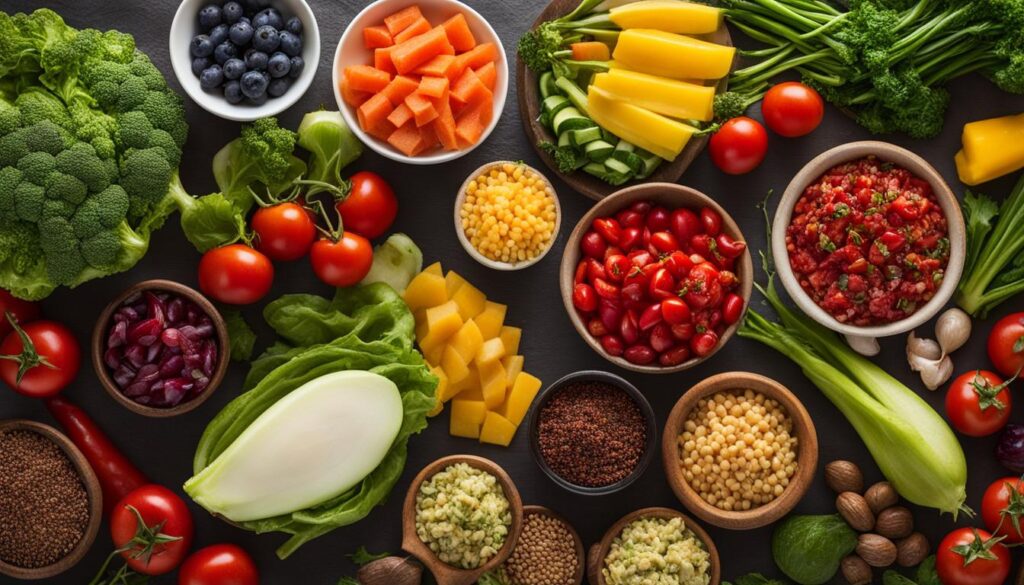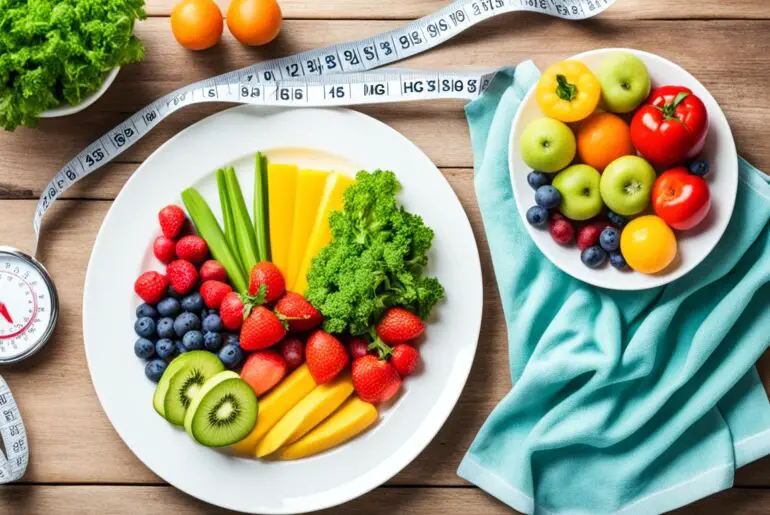Are you struggling to stay full and satisfied while following the HCG Diet Plan? It’s no secret that the HCG Diet involves a strict 500-calorie per day intake, which can leave some people feeling hungry and deprived. However, what if I told you that there are ways to stay satiated and satisfied on this protocol?
In this article, I will share with you some valuable tips and strategies to help you feel fuller for longer while following the HCG Diet Plan. From choosing the right foods to incorporating the right techniques, you can navigate through this weight loss journey without feeling like you’re constantly battling hunger. So, let’s dive in and discover how to stay full and satisfied on the HCG Diet!
Key Takeaways:
- Discover how to feel satiated while on the HCG Diet Plan.
- Learn about the recommended food choices to stay full on this protocol.
- Explore strategies to overcome hunger and cravings during the diet.
- Understand the importance of portion control and meal planning on the HCG Diet.
- Find out how to navigate through the different phases of the HCG Diet while staying satisfied.
Understanding the HCG Diet Plan
The HCG Diet Plan is a comprehensive weight loss program created specifically for individuals struggling with obesity. It is a medically supervised protocol that consists of several distinct phases, each serving a specific purpose in the weight loss journey.
The different phases of the HCG Diet Plan include the loading phase, the fat burn phase, and the maintenance phase. Each phase has its own goals and guidelines to ensure maximum effectiveness and success.
The Loading Phase
During the loading phase, participants are encouraged to consume high-calorie, fatty foods. This phase typically lasts for two days and is designed to help the body build up fat reserves to be used as a source of energy during the subsequent phases.
Participants may consume foods such as avocados, nuts, butter, and other high-fat items to increase calorie intake. This phase is an essential component of the HCG Diet Plan, as it prepares the body for the calorie-restricted phases that follow.
The Fat Burn Phase
The fat burn phase is the core of the HCG Diet Plan. During this phase, participants strictly adhere to a low-calorie diet of 500 calories per day, combined with regular injections of HCG hormone. The HCG hormone helps to suppress appetite, mobilize stored fat, and prevent muscle loss.
The diet during this phase primarily consists of lean proteins, such as chicken breast, fish, and lean beef, along with a variety of vegetables and limited fruits. Starches and sugars are strictly avoided to maximize fat burning.
It is crucial to carefully measure and portion the recommended foods to ensure that the calorie limit is not exceeded. Following the diet protocol during the fat burn phase is essential for achieving significant weight loss.
The Maintenance Phase
The maintenance phase is the final phase of the HCG Diet Plan. After completing the fat burn phase, participants enter a three-week period of gradually reintroducing different foods into their diet. The goal of this phase is to stabilize the new weight and establish healthy eating habits for long-term weight maintenance.
During the maintenance phase, participants are advised to follow a calorie range of 1500-2000 calories per day, avoiding sugars and starches as much as possible. This phase is crucial for maintaining the weight loss achieved during the previous phases.
Benefits of the HCG Diet Plan
- Significant weight loss
- Preservation of muscle mass
- Increased metabolism
- Improved body composition
By strictly following the HCG Diet Plan, individuals can achieve their weight loss goals in a safe and effective manner. It is important to consult with a healthcare professional before embarking on any weight loss program to ensure it is suitable for individual health.
| Phase | Duration | Main Focus |
|---|---|---|
| Loading Phase | 2 days | Build up fat reserves |
| Fat Burn Phase | 21 or 40 days | Mobilize stored fat |
| Maintenance Phase | 3 weeks | Stabilize weight, establish healthy habits |
Phase 1 – Gorging/Loading

Phase 1 of the HCG Diet Plan is known as the Gorging or Loading phase. During this phase, participants are instructed to consume as much fatty and oily foods as possible while starting the HCG injections. The purpose of this phase is to build up normal fat reserves and prepare the body for the low-calorie phase. It is important to eat until feeling sick to ensure adequate fat stores for energy during the next phase.
Phase 2 – Fat Burn
Phase 2 of the HCG Diet Plan, also known as the Fat Burn phase, is a crucial stage for achieving significant weight loss. This phase typically begins on day 3 and continues for either 21 or 40 days, depending on the individual’s weight loss goals. During this phase, participants follow a highly restrictive 500-calorie per day diet and continue taking HCG injections.
The HCG Diet Plan during the Fat Burn phase focuses on specific food choices that promote fat burning and prevent muscle loss. It is essential to strictly adhere to the recommended food choices and portion sizes for optimal results. The diet primarily consists of lean proteins, vegetables, fruits, and limited quantities of starches.
Food Choices for the Fat Burn Phase
During the Fat Burn phase, participants are encouraged to consume the following:
- Lean proteins: Chicken breast, beef, veal, white fish, lobster, crab, or shrimp.
- Vegetables: A variety of vegetables such as spinach, lettuce, cucumbers, tomatoes, onions, and asparagus.
- Fruits: Small portions of fruits such as apples, oranges, strawberries, or grapefruits.
- Starches: Limited quantities of certain types of crackers or substitutes for vegetarians.
It is crucial to weigh all protein portions raw and remove any visible fat before cooking. Following the recommended food choices and portion sizes is essential for staying full and satisfied while maximizing fat burning.
Here is a visual representation of the recommended food choices for the Fat Burn phase:
| Food Group | Examples |
|---|---|
| Lean Proteins | Chicken breast, beef, veal, white fish, lobster, crab, shrimp |
| Vegetables | Spinach, lettuce, cucumbers, tomatoes, onions, asparagus |
| Fruits | Apples, oranges, strawberries, grapefruits |
| Starches | Specific crackers or substitutes for vegetarians |
By following the recommended food choices and portion sizes during the Fat Burn phase, participants can optimize their fat-burning potential and achieve their weight loss goals.
HCG Diet Food Choices

When following the HCG Diet Plan, it is crucial to make the right food choices to stay full and satisfied. In the Fat Burn phase of the diet, there are specific foods that participants can include in their meals. These food choices provide the necessary nutrients while keeping calorie intake low.
Protein Choices
Lean proteins are the cornerstone of the HCG Diet Plan. They provide essential amino acids and help maintain muscle mass during the fat burning process. Some recommended protein options include:
- Chicken breast
- Beef (extra lean cuts)
- Veal
- White fish
- Lobster
- Crab
- Shrimp
It is important to weigh all protein portions raw and remove any visible fat before cooking. This helps ensure accurate portion sizes and keeps calorie intake in check.
Fruits and Vegetables
While on the HCG Diet, fruits and vegetables are allowed in limited quantities. These provide essential vitamins, minerals, and fiber. Some recommended options include:
- Apples
- Oranges
- Strawberries
- Grapefruit
- Spinach
- Cucumbers
- Cabbage
It is important to note that the consumption of fruits and vegetables should be limited to the recommended portion sizes to maintain the desired calorie intake.
Starches
During the Fat Burn phase of the HCG Diet Plan, starches are restricted. However, there are certain options available for those who require substitutes or are following a vegetarian diet. Some allowed starch choices include certain types of crackers and vegetarian substitutes.
By following the recommended food choices and portion sizes, individuals can stay full and satisfied while on the HCG Diet. It is important to remember that adhering to the guidelines is crucial for the success of the diet and achieving desired weight loss goals.
HCG Diet Plateau Breakers
Plateau breakers are essential strategies to overcome weight loss stalls during the HCG Diet. If you experience a slowdown or halt in weight loss, there are several options available to boost your progress and get back on track.
- Increasing water intake: Staying hydrated is vital for overall health and weight loss. Drinking an adequate amount of water can help flush out toxins and support your body’s natural fat-burning processes. Aim to drink at least eight glasses of water per day.
- Adjusting protein portions: Protein is a critical component of the HCG Diet. If you are experiencing a plateau, consider reducing or increasing your protein portions slightly. Experimenting with different protein amounts may help kickstart your weight loss again.
- Consuming only apples for a day: An apple day is a common technique used to break through weight loss stalls. On this day, you only eat six apples throughout the day, spacing them out evenly. This method can help reset your metabolism and jumpstart further fat burning.
- Cutting down on beef: Beef is a high-calorie protein option on the HCG Diet. If you have been consuming beef regularly, try reducing or eliminating it for a few days. opt for other lean protein sources like chicken, fish, or tofu instead.
- Avoiding certain condiments: Some condiments, such as ketchup, pickles, and barbecue sauce, may contain hidden sugars or additives that can hinder weight loss. Check the labels of condiments and avoid those that are high in sugar and other undesirable ingredients.
- Checking for additives in protein sources: Ensure that your protein sources do not contain any additives or hidden ingredients that can interfere with the HCG Diet. Processed meats or protein powders may contain hidden sugars, fillers, or preservatives that can impede weight loss.
It’s important to note that factors other than diet can contribute to weight loss stalls. Check if you have reached your ideal weight and if further weight loss is necessary. Hormonal changes, certain medications, and poor sleep quality can also affect your progress. Incorporating regular exercise into your routine and adding apple cider vinegar to your diet may also help overcome plateaus.
By implementing these plateau breakers and closely monitoring your progress, you can overcome weight loss stalls and continue your successful journey on the HCG Diet.
Things to Avoid on the HCG Diet

When following the HCG Diet, there are certain restrictions and dos and don’ts that need to be followed to maximize weight loss and prevent any potential setbacks. Adhering to these guidelines is crucial for the effectiveness of the HCG Diet Plan.
Avoid Exceeding the Calorie Limit
The HCG Diet requires strict adherence to a 500-calorie per day limit. It is essential to avoid any extra foods or beverages that are not included in the plan. This restriction is necessary for achieving optimal weight loss and maintaining the metabolic state induced by the HCG hormone.
Minimize the Use of Oils and High-Fat Products
While on the HCG Diet, it is important to minimize the use of oils and high-fat products in personal care items such as shampoo, lotion, and toothpaste. These products can contain hidden fats that may interfere with the fat-burning process and hinder weight loss progress.
Avoid Sunbathing and Intense Exercise
Sunbathing and intense exercise can potentially affect water retention and weight loss on the HCG Diet. It is recommended to avoid prolonged sun exposure, as it may cause water retention and fluctuations in weight. Additionally, intense exercise can put additional stress on the body while on a low-calorie diet, potentially leading to muscle loss.
| Things to Avoid on the HCG Diet | Reasons |
|---|---|
| Exceeding the calorie limit | To maintain the metabolic state induced by the HCG hormone and optimize weight loss. |
| Using oils and high-fat products in personal care items | To prevent interference with the fat-burning process and support ongoing weight loss. |
| Sunbathing and intense exercise | To avoid water retention and potential muscle loss while on a low-calorie diet. |
By avoiding these restrictions and following the recommended guidelines, individuals can ensure the effectiveness of the HCG Diet Plan and achieve their weight loss goals.
HCG Diet Tracking Chart
![]()
A tracking chart is an essential tool for monitoring your progress on the HCG Diet. It allows you to record your daily weight and jot down any notes or observations that may be helpful. By keeping track of your weight changes over time, you can identify patterns, track your progress, and determine the effectiveness of the diet for you.
Regular weigh-ins are important to accurately track your progress and make any necessary adjustments to your diet plan. Consistency is key, so try to weigh yourself at the same time each day, preferably in the morning after using the bathroom and before eating or drinking anything. Remember to use the same scale each time to ensure consistent measurements.
In addition to tracking your weight, consider also keeping a record of other measurements such as waist circumference, hip circumference, and body fat percentage. This comprehensive tracking approach provides a more holistic view of your progress and can help motivate and inspire you throughout your journey.
Noting any observations, such as cravings, energy levels, or changes in appetite, can provide valuable insight into how your body is responding to the diet. This information can guide you in making adjustments to your food choices or portion sizes.
One way to visually represent your progress is by creating a progress chart. This can be a simple table or graph that displays your weight or measurements over time. Seeing your progress visually can be highly motivating and remind you of how far you’ve come.
Keep in mind that weight loss is not always linear, and you may experience periods of plateau or slower progress. Don’t get discouraged; instead, use these moments as opportunities to assess and adjust your diet plan and exercise regimen if necessary. Your tracking chart can help you identify these plateaus and track your progress through them.
Remember, the HCG Diet is a unique journey for each individual, and your progress may differ from others’. Focus on your personal goals, stay consistent with your tracking, and adjust your plan as needed to maximize your success.
Sample HCG Diet Tracking Chart
| Date | Weight (lbs) | Waist Circumference (inches) | Hip Circumference (inches) | Body Fat Percentage |
|---|---|---|---|---|
| Day 1 | 200 | 35 | 40 | 30% |
| Day 3 | 195 | 34 | 39 | 28% |
| Day 7 | 192 | 33 | 38 | 26% |
| Day 14 | 188 | 32 | 37 | 24% |
| Day 21 | 185 | 31 | 36 | 22% |
Phase 3 – Maintenance Phase

After completing the fat burn phase of the HCG Diet Plan, participants enter Phase 3, also known as the Maintenance phase. This phase is essential for stabilizing the new weight and establishing a long-term maintenance plan. During this phase, it is important to adhere to a calorie range of 1500-2000 calories per day and avoid sugars and starches to prevent weight regain.
Phase 3 of the HCG Diet allows for the gradual reintroduction of different foods back into the diet. By slowly adding foods one at a time, participants can identify any potential triggers or sensitivities that may affect their weight or overall well-being. It is recommended to introduce new foods every few days and closely monitor the body’s response.
To maintain the achieved weight loss, individuals should continue to focus on portion control, balanced nutrition, and mindful eating. Daily weight monitoring is crucial during this phase, as any significant deviations should be addressed promptly to prevent further weight fluctuations.
Sample Meal Plan for Phase 3
Here is a sample meal plan for Phase 3 of the HCG Diet:
| Time | Meal |
|---|---|
| Breakfast | Spinach omelet with tomatoes and feta cheese |
| Snack | Handful of almonds |
| Lunch | Grilled chicken breast with mixed greens salad |
| Snack | Carrot sticks with hummus |
| Dinner | Salmon fillet with steamed broccoli and quinoa |
| Snack | Greek yogurt with berries |
Remember, this is just a sample meal plan, and individual dietary needs may vary. It’s essential to consult with a healthcare professional or a registered dietitian to develop a personalized maintenance plan that suits your specific goals and needs.
Tips for Successful Maintenance
- Continue practicing portion control and mindful eating.
- Focus on whole, nutrient-dense foods.
- Avoid processed foods, sugars, and starchy carbs.
- Incorporate regular physical activity and exercise into your routine.
- Stay hydrated by drinking plenty of water.
- Monitor your weight regularly and take action if any significant changes occur.
- Seek support from a healthcare professional or a registered dietitian for guidance and accountability.
By following these guidelines and maintaining a healthy lifestyle, you can successfully transition into the maintenance phase of the HCG Diet and sustain your weight loss for the long term.
HCG Diet Success Tips
When it comes to maximizing success on the HCG Diet Plan, it’s important to follow a few key tips and recommendations. These strategies can help you stay focused, motivated, and on track throughout your journey. Here are some HCG Diet success tips to keep in mind:
- Mentally prepare for the diet: The HCG Diet requires discipline and commitment. Take some time to mentally prepare yourself for the challenges ahead and the changes you’ll be making to your eating habits.
- Plan meals ahead of time: Meal planning is crucial on the HCG Diet. By prepping your meals in advance, you can ensure that you have healthy and compliant options readily available, making it easier to stick to the plan.
- Know your weight loss goals: Set realistic and achievable goals for your weight loss journey. Knowing what you want to achieve can help you stay motivated and dedicated to the diet.
- Drink enough water: Staying hydrated is essential for overall health and weight loss. Aim to drink at least 8 cups of water per day while on the HCG Diet.
- Avoid temptation: It’s important to eliminate tempting foods and snacks from your surroundings. Remove any non-compliant foods from your pantry and stock up on nutritious options that align with the HCG Diet plan.
Consistency is Key
Consistency is crucial when it comes to achieving long-term success on the HCG Diet. Here are a few additional tips to help you maintain consistency throughout your journey:
- Follow the diet guidelines: Stick to the recommended food choices, portion sizes, and calorie restrictions outlined in the HCG Diet plan. Consistency in following these guidelines is key to achieving optimal results.
- Track your progress: Keep a journal or use a tracking app to monitor your weight, measurements, and other relevant data. Tracking your progress can help you stay accountable and identify any areas that may need adjustment.
- Incorporate exercise during the maintenance phase: Once you’ve completed the fat burn phase and entered the maintenance phase, consider incorporating regular exercise into your routine. Physical activity not only supports weight maintenance but also contributes to overall health and well-being.
By following these HCG Diet success tips and staying consistent with the program, you can increase your chances of achieving your weight loss goals and maintaining a healthy lifestyle in the long run.
Conclusion
The HCG Diet Plan provides a structured and medically supervised approach to achieving significant weight loss. By following the guidelines and incorporating healthy habits, individuals can stay full and satisfied while working towards their weight loss goals. It is crucial to consult with a healthcare professional before starting any diet or weight loss program to ensure safety and effectiveness.
With commitment and adherence to the HCG Diet Plan, individuals can experience successful and sustainable weight loss. The program emphasizes the consumption of recommended foods and portion sizes, helping to maximize fat burning while preserving muscle mass. By strictly following the diet protocol, individuals can achieve their desired weight loss results.
It is important to remember that the HCG Diet Plan is not a quick fix or a one-size-fits-all solution. It requires dedication, discipline, and ongoing commitment to long-term lifestyle changes. Consulting with a healthcare professional and incorporating regular exercise can further enhance the effectiveness of the program. By embracing the HCG Diet Plan’s principles and making healthy choices, individuals can achieve their weight loss goals and maintain a healthier lifestyle.
FAQ
How can I stay full on the HCG Diet Plan?
Staying full on the HCG Diet Plan can be challenging due to the low-calorie restriction. However, there are several strategies to help manage hunger and increase satisfaction. These include consuming high-protein foods, drinking plenty of water, incorporating fiber-rich fruits and vegetables, and spacing meals throughout the day.
What is the HCG Diet Plan?
The HCG Diet Plan is a medically supervised weight loss program that combines the administration of HCG hormone with a strict 500-calorie per day diet. It consists of different phases, including a loading phase, fat burn phase, and maintenance phase, aiming to mobilize stored fat, prevent muscle loss, and establish long-term weight management.
What is Phase 1 of the HCG Diet Plan?
Phase 1, also known as the Gorging or Loading phase, occurs at the beginning of the HCG Diet Plan. During this phase, participants are instructed to consume as many fatty and oily foods as possible while starting the HCG injections. This phase helps build up normal fat reserves and prepare the body for the low-calorie phase.
What is Phase 2 of the HCG Diet Plan?
Phase 2, the Fat Burn phase, starts on day 3 and lasts for 21 or 40 days, depending on the weight loss goals. Participants consume only 500 calories per day and continue taking HCG injections. The diet consists of specific protein choices, vegetables, fruits, and limited starches. Following the food choices and portion sizes strictly maximizes fat burning and prevents muscle loss.
What are the food choices on the HCG Diet?
The HCG Diet includes specific food choices for each phase. In the Fat Burn phase, participants can consume lean proteins such as chicken breast, beef, veal, white fish, lobster, crab, or shrimp. Fruits and vegetables are also allowed in limited quantities, along with certain types of crackers and substitutes for vegetarians. It is important to weigh protein portions raw and remove visible fat before cooking.
How can I overcome weight loss plateaus on the HCG Diet?
Plateau breakers can help overcome weight loss stalls during the HCG Diet. If weight loss slows or halts, options include increasing water intake, adjusting protein portions, consuming only apples for a day, cutting down on beef, avoiding certain condiments, and checking for additives in protein sources. Factors like reaching ideal weight, hormonal changes, medications, and sleep quality should also be considered.
What should I avoid on the HCG Diet?
To maximize weight loss and avoid setbacks, it is important to strictly adhere to the 500-calorie per day limit and avoid any extra foods or beverages not included in the plan. Minimize the use of oils and high-fat products in personal care items like shampoo, lotion, and toothpaste. Sunbathing and intense exercise may also affect water retention and weight loss.
How can I track my progress on the HCG Diet?
Using a tracking chart is an effective tool to monitor progress on the HCG Diet. It allows participants to record their daily weight and any notes or observations. Regular weigh-ins, consistent sleep patterns, and daily self-measurements are important for accurately tracking progress and adjusting the diet accordingly.
What is Phase 3 of the HCG Diet Plan?
Phase 3, the Maintenance phase, begins after completing the fat burn phase. It consists of a three-week period during which participants gradually reintroduce different foods into their diet. The goal is to stabilize the new weight and establish a long-term maintenance plan. Daily weight monitoring and adherence to a calorie range of 1500-2000 calories per day are crucial during this phase.
What are some tips for success on the HCG Diet Plan?
To maximize success on the HCG Diet Plan, it is important to mentally prepare for the diet, plan meals ahead of time, establish weight loss goals, drink enough water, and avoid temptation. Consistency in following the diet guidelines, tracking progress, and incorporating exercise during the maintenance phase can also contribute to long-term success.




